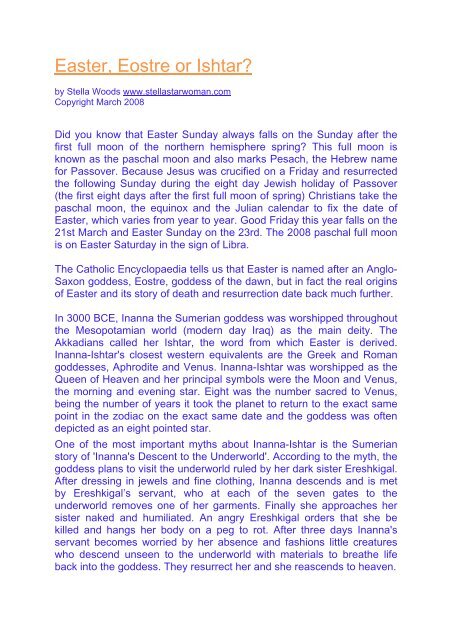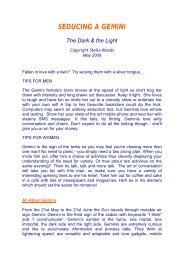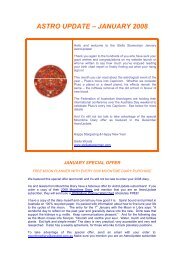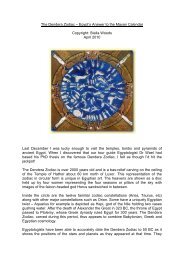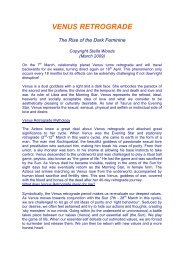Easter, Eostre or Ishtar? - Stella Starwoman
Easter, Eostre or Ishtar? - Stella Starwoman
Easter, Eostre or Ishtar? - Stella Starwoman
Create successful ePaper yourself
Turn your PDF publications into a flip-book with our unique Google optimized e-Paper software.
<strong>Easter</strong>, <strong>Eostre</strong> <strong>or</strong> <strong>Ishtar</strong>?<br />
by <strong>Stella</strong> Woods www.stellastarwoman.com<br />
Copyright March 2008<br />
Did you know that <strong>Easter</strong> Sunday always falls on the Sunday after the<br />
first full moon of the n<strong>or</strong>thern hemisphere spring? This full moon is<br />
known as the paschal moon and also marks Pesach, the Hebrew name<br />
f<strong>or</strong> Passover. Because Jesus was crucified on a Friday and resurrected<br />
the following Sunday during the eight day Jewish holiday of Passover<br />
(the first eight days after the first full moon of spring) Christians take the<br />
paschal moon, the equinox and the Julian calendar to fix the date of<br />
<strong>Easter</strong>, which varies from year to year. Good Friday this year falls on the<br />
21st March and <strong>Easter</strong> Sunday on the 23rd. The 2008 paschal full moon<br />
is on <strong>Easter</strong> Saturday in the sign of Libra.<br />
The Catholic Encyclopaedia tells us that <strong>Easter</strong> is named after an Anglo-<br />
Saxon goddess, <strong>Eostre</strong>, goddess of the dawn, but in fact the real <strong>or</strong>igins<br />
of <strong>Easter</strong> and its st<strong>or</strong>y of death and resurrection date back much further.<br />
In 3000 BCE, Inanna the Sumerian goddess was w<strong>or</strong>shipped throughout<br />
the Mesopotamian w<strong>or</strong>ld (modern day Iraq) as the main deity. The<br />
Akkadians called her <strong>Ishtar</strong>, the w<strong>or</strong>d from which <strong>Easter</strong> is derived.<br />
Inanna-<strong>Ishtar</strong>'s closest western equivalents are the Greek and Roman<br />
goddesses, Aphrodite and Venus. Inanna-<strong>Ishtar</strong> was w<strong>or</strong>shipped as the<br />
Queen of Heaven and her principal symbols were the Moon and Venus,<br />
the m<strong>or</strong>ning and evening star. Eight was the number sacred to Venus,<br />
being the number of years it took the planet to return to the exact same<br />
point in the zodiac on the exact same date and the goddess was often<br />
depicted as an eight pointed star.<br />
One of the most imp<strong>or</strong>tant myths about Inanna-<strong>Ishtar</strong> is the Sumerian<br />
st<strong>or</strong>y of 'Inanna's Descent to the Underw<strong>or</strong>ld'. Acc<strong>or</strong>ding to the myth, the<br />
goddess plans to visit the underw<strong>or</strong>ld ruled by her dark sister Ereshkigal.<br />
After dressing in jewels and fine clothing, Inanna descends and is met<br />
by Ereshkigal’s servant, who at each of the seven gates to the<br />
underw<strong>or</strong>ld removes one of her garments. Finally she approaches her<br />
sister naked and humiliated. An angry Ereshkigal <strong>or</strong>ders that she be<br />
killed and hangs her body on a peg to rot. After three days Inanna's<br />
servant becomes w<strong>or</strong>ried by her absence and fashions little creatures<br />
who descend unseen to the underw<strong>or</strong>ld with materials to breathe life<br />
back into the goddess. They resurrect her and she reascends to heaven.
There are many variations on this myth, but its imp<strong>or</strong>tance lies in the<br />
theme of death and rebirth. At the time of the new moon, the moon<br />
(Inanna) disappears from sight f<strong>or</strong> three days as she conjuncts the Sun<br />
and is then revealed again. Similarly, the planet Venus (Inanna)<br />
disappears from sight when moving from being the M<strong>or</strong>ning Star (rising<br />
bef<strong>or</strong>e the Sun) to the Evening Star (setting after the Sun). On a physical<br />
level Inanna’s rebirth heralds the coming of spring (remember these<br />
myths are set in the N<strong>or</strong>thern hemisphere where <strong>Easter</strong> is in spring). On<br />
a psychological level, Inanna’s descent to meet her dark sister<br />
Ereshkigal represents the encounter with our shadow side <strong>or</strong><br />
unconscious. When we return to the light after a period of darkness, we<br />
have the opp<strong>or</strong>tunity to become whole. This same theme is reflected in<br />
the tarot card of the Hanged Man who voluntarily hangs upside down in<br />
an act of sacrifice as a prelude to death and transf<strong>or</strong>mation.<br />
Note the similarities between the Inanna-<strong>Ishtar</strong> myth and the st<strong>or</strong>y of<br />
Jesus. As <strong>Ishtar</strong> descended, she was stripped and humiliated; Jesus<br />
was stripped, beaten and humbled. <strong>Ishtar</strong> was killed and hung on a<br />
stake; Jesus was hung on a cross. <strong>Ishtar</strong> was resurrected after three<br />
days; Jesus rose from the dead on the third day. Both achieved eternal<br />
life. <strong>Easter</strong> is in fact the same st<strong>or</strong>y as <strong>Ishtar</strong>.<br />
F<strong>or</strong> many of us festivals such as <strong>Easter</strong> and Christmas have lost their<br />
<strong>or</strong>iginal meaning and simply become holidays <strong>or</strong> times of conspicuous<br />
consumption. We do not realise that in celebrating <strong>Easter</strong>, we are<br />
participating in an age-old ritual celebrating the return to the light after a<br />
period of darkness and death.


